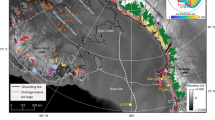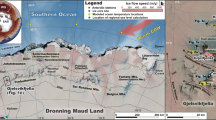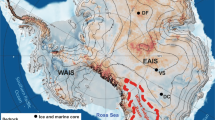Abstract
During the middle and late Eocene (∼ 48–34 Myr ago), the Earth’s climate cooled1,2 and an ice sheet built up on Antarctica. The stepwise expansion of ice on Antarctica3,4 induced crustal deformation and gravitational perturbations around the continent. Close to the ice sheet, sea level rose5,6 despite an overall reduction in the mass of the ocean caused by the transfer of water to the ice sheet. Here we identify the crustal response to ice-sheet growth by forcing a glacial-hydro isostatic adjustment model7 with an Antarctic ice-sheet model. We find that the shelf areas around East Antarctica first shoaled as upper mantle material upwelled and a peripheral forebulge developed. The inner shelf subsequently subsided as lithosphere flexure extended outwards from the ice-sheet margins. Consequently the coasts experienced a progressive relative sea-level rise. Our analysis of sediment cores from the vicinity of the Antarctic ice sheet are in agreement with the spatial patterns of relative sea-level change indicated by our simulations. Our results are consistent with the suggestion8 that near-field processes such as local sea-level change influence the equilibrium state obtained by an ice-sheet grounding line.
This is a preview of subscription content, access via your institution
Access options
Subscribe to this journal
Receive 12 print issues and online access
$259.00 per year
only $21.58 per issue
Buy this article
- Purchase on Springer Link
- Instant access to full article PDF
Prices may be subject to local taxes which are calculated during checkout



Similar content being viewed by others
References
Zachos, J. C., Dickens, G. R & Zeebe, R. E. An early Cenozoic perspective on greenhouse warming and carbon-cycle dynamics. Nature 451, 279–283 (2008).
Liu, Z. et al. Global cooling during the Eocene–Oligocene climate transition. Science 323, 1187–1190 (2009).
Coxall, H. K. & Wilson, P. A. Early Oligocene glaciation and productivity in the eastern equatorial Pacific: Insights into global carbon cycling. Palaeoceanography 26, PA2221 (2011).
Scher, H. D., Bohaty, S. M., Zachos, J. C. & Delaney, M. L. Two-stepping into the icehouse: East Antarctic weathering during progressive ice-sheet expansion at the Eocene - Oligocene transition. Geology 39, 383–386 (2011).
Woodward, R. S. On the form and position of mean sea level. United States Geol. Surv. Bull. 48, 87–170 (1888).
Raymo, M. E. et al. Departures from eustasy in Pliocene sea-level records. Nature Geosci. 4, 328–332 (2011).
Kendall, R. et al. On post-glacial sea level– II. Numerical formulation and comparative results on spherycally symmetric models. Geophys. J. Int. 154, 253–267 (2003).
Gomez, N. et al. Evolution of a coupled marine ice sheet-sea level model. J. Geophys. Res. 117, F01013 (2012).
Zachos, J. C., Quinn, T. M. & Salamy, K. A. High-resolution (10 4 years) deep-sea foraminiferal stable isotope records of the Eocene-Oligocene climate transition. Palaeoceanography 11, 251–266 (1996).
Lear, C. H., Bailey, T. R., Pearson, P. N., Coxall, H. K. & Rosenthal, Y. Cooling and ice growth across the Eocene-Oligocene transition. Geology 36, 251–254 (2008).
Wade, B. S. et al. Multiproxy record of abrupt sea-surface cooling across the Eocene Oligocene transition in the Gulf of Mexico. Geology 40, 251–254 (2008).
Bohaty, S. M., Delaney, M. L. & Zachos, J. C. Foraminiferal Mg/Ca Evidence for Southern Ocean Cooling across the Eocene-Oligocene Transition. Earth Planet. Sci. Lett. 317–318, 251–261 (2012).
Kominz, M. A. & Pekar, S. F. Oligocene eustasy from two-dimensional sequence stratigraphic backstripping. GSA Bull. 113, 291–304 (2001).
Miller, K. G. et al. Eocene–Oligocene global climate and sea-level changes: St. Stephens Quarry, Alabama. GSA Bull. 120, 34–53 (2008).
Houben, A. J. P. et al. The Eocene–Oligocene transition: Changes in sea level, temperature or both? Palaeogeogr. Palaeoclimatol. Palaeoecol. 335–336, 75–83 (2012).
Gomez, N. et al. A new projection of sea level change in response to collapse of marine sectors of the Antarctic Ice-Sheet. Geophys. J. Int. 180, 623–634 (2010).
Boulton, G. S. in Glaciomarine Environments. Processes and Sediments Vol. 53 (eds Dowdeswell, J. A. & Scourse, J. D.) 15–52 (Geological Society of London, Special Publications, 1990).
DeConto, R. & Pollard, D. Rapid Cenozoic Antarctic glaciation of Antarctica induced by declining atmospheric CO2 . Nature 421, 245–249 (2003).
Escutia, C. et al. Proc. Integrated Ocean Drilling Program 318 (Integrated Ocean Drilling Program Management International, 2011).
Fielding, et al. Facies architecture of the CRP-3 drillhole, Victoria Land Basin, Antarctica. Terr. Antarct. 8, 217–224 (2001).
Galeotti, S. et al. Cyclochronology of the Eocene–Oligocene transition from a glacimarine succession off the Victoria Land coast, Cape Roberts Project, Antarctica. Palaeogeogr. Palaeoclimatol. Palaeoecol. 335–336, 84–94 (2012).
Barron, J. B. et al. Proc. ODP Scientific Results Leg 119 (Ocean Drilling Program, 1991).
O’Brien, P. E. et al. Proc. ODP, Init. Repts., 188 (Ocean Drilling Program, 2001).
Wilson, D. S. et al. Antarctic topography at the Eocene–Oligocene Boundary. Palaeogeogr. Palaeoclimatol. Palaeoecol. 335–336, 24–36 (2012).
Escutia, et al. Cenozoic ice-sheet history from east Antarctic Wilkes Land continental margin sediments. Glob. Planet. Change 45, 51–81 (2005).
Close, D. I., Watts, A. B. & Stagg, H. M. J. A marine geophysical study of the Wilkes Land rifted continental margin, Antarctica. Geophys. J. Int. 177, 430–450 (2009).
Stickley, C. E. et al. Timing and nature of the deepening of the Tasmanian Gateway. Paleoceanography 19, PA4027 (2004).
Hambrey, M. J., Ehrmann, W. U. & Larsen, B. in Proc. Ocean Drilling Program, Scientific Results Vol. 119 (eds Barron, J. B. et al.) 77–132 (Ocean Drilling Program, 1991).
Erohina, T. et al. in Proc. ODP, Sci. Results Vol. 188 (eds Cooper, A. K., O’Brien, P. E. & Richter, C.) 1–21 (Ocean Drilling Program, 2004).
Pollard, D & DeConto, R. M. Modelling West Antarctic ice sheet growth and collapse through the past five million years. Nature 458, 329–332 (2008).
Acknowledgements
This work was financially supported by the Netherlands Organization for Scientific Research (NWO, Project Number ALW-GO-A0/02-05). P.S. acknowledges financial support from the Academy Professorship awarded by the Royal Netherlands Academy of Arts and Sciences (KNAW) to H. Oerlemans. C.E. acknowledges financial support from the Spanish Ministry of Science and Education grant No. CTM2011-24079. A.J.P.H. acknowledges financial support from Statoil. S.P. acknowledges support from the National Science Foundation’s Office of Polar Programs (Award Number ANT-1245283). The authors are grateful to IODP for the samples collected during Expedition 318 to Wilkes Land. This research has been sponsored by the COST Action ES0701. The authors are grateful to VPRO TV and the Beagle Series. Further support was provided by the US National Foundation under awards ANT-0424589, 1043018 and OCE-1202632.
Author information
Authors and Affiliations
Contributions
P.S., C.E., H.B., B.L.A.V., A.J.P.H. and P.K.B. designed the research. P.S. and B.L.A.V. performed the GIA simulations. A.J.P.H., P.K.B., S.G., S.P. and C.E. compiled and generated field data. C.E. generated seismic stratigraphy data. R.M.D. and D.P. generated the ice-sheet model. All authors contributed to writing the paper.
Corresponding authors
Ethics declarations
Competing interests
The authors declare no competing financial interests.
Supplementary information
Supplementary Information
Supplementary Information (PDF 13287 kb)
Rights and permissions
About this article
Cite this article
Stocchi, P., Escutia, C., Houben, A. et al. Relative sea-level rise around East Antarctica during Oligocene glaciation. Nature Geosci 6, 380–384 (2013). https://doi.org/10.1038/ngeo1783
Received:
Accepted:
Published:
Issue Date:
DOI: https://doi.org/10.1038/ngeo1783
This article is cited by
-
Solid Earth change and the evolution of the Antarctic Ice Sheet
Nature Communications (2019)
-
Antarctic glacio-eustatic contributions to late Miocene Mediterranean desiccation and reflooding
Nature Communications (2015)
-
Antarctic contribution to meltwater pulse 1A from reduced Southern Ocean overturning
Nature Communications (2014)



